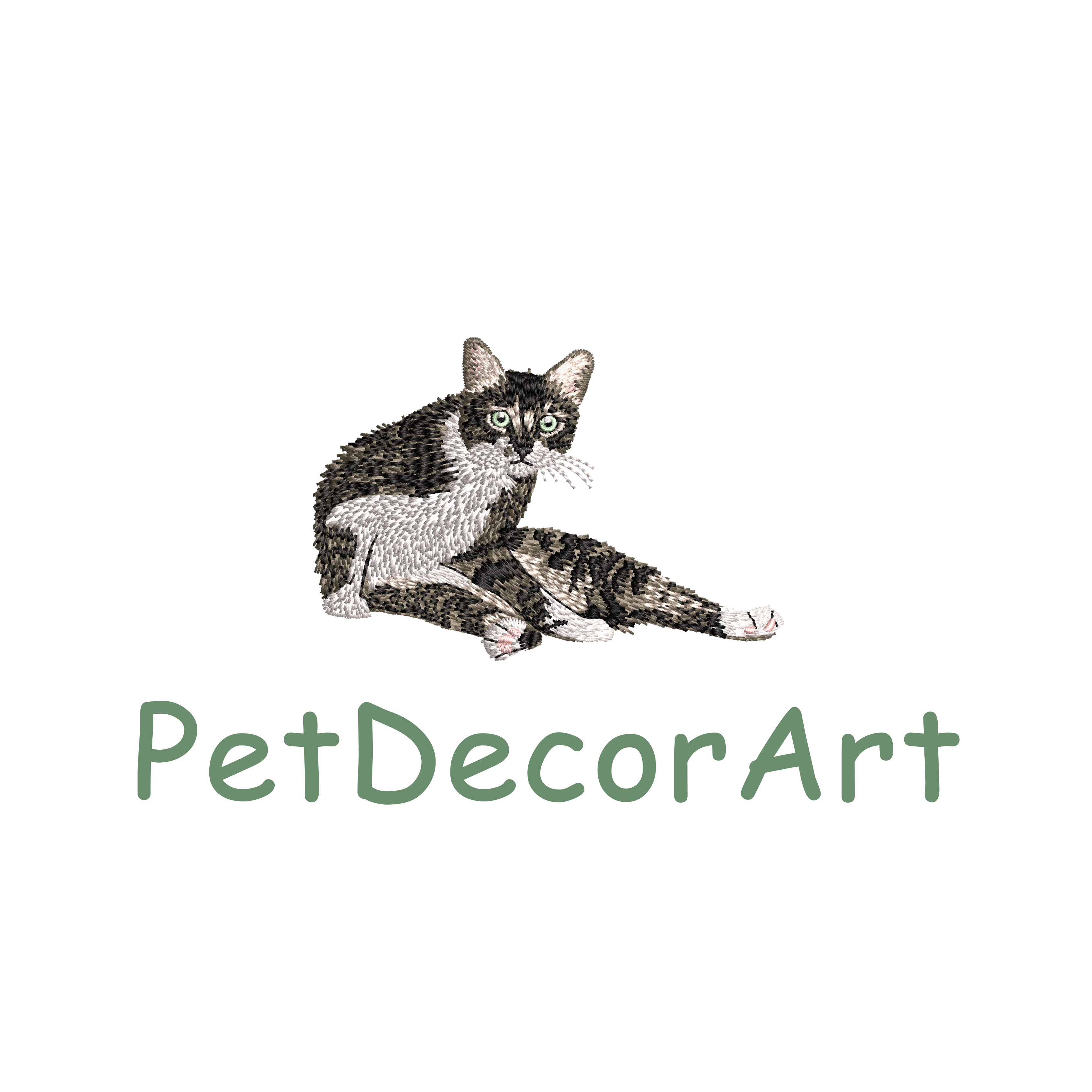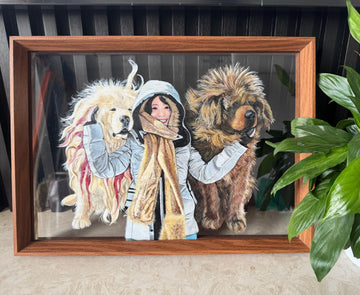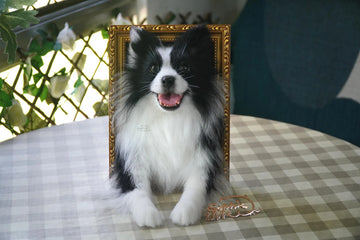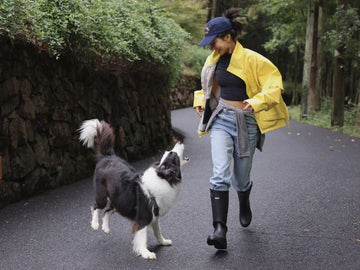Thinking mode: Most people imagine oil painting as brush and canvas. But glass can also be a luminous stage for oil, turning light into a collaborator. When the subject is a beloved pet or a cherished memory, choosing between traditional oil and glass oil becomes less about “better” and more about what kind of presence you want on your wall: painterly warmth, crystalline clarity, or a layered 3D depth that changes as you move.
Table of Contents
- 1. What Is a Glass Oil Painting?
- 2. Two Types: Flat Glass vs. 3D Glass (Layered)
- 3. What Is a Traditional Oil Painting?
- 4. Key Differences at a Glance
- 5. How Each Method Works (Step by Step)
- 6. When to Choose Flat Glass, 3D Glass, or Traditional
- 7. Pet Portrait Use Cases (with Commissioning Tips)
- 8. Lighting & Display: Getting the Glow Right
- 9. Care, Longevity & Framing
- 10. Budget & Timeline: What to Expect
- 11. Decision Guide: A Quick Checklist
- 12. FAQ
- Conclusion
1) What Is a Glass Oil Painting?
Glass oil painting uses glass as the support (the surface that holds the paint). Instead of canvas or wood, the artist prepares a glass panel and paints with oils to exploit glass’s optical clarity and sleek surface. The effect can range from ultra-clean lines and jewel-like color to layered depth that creates a subtle parallax when you move around the piece.
Some artists paint on the front of glass (like painting on canvas). Others paint on the reverse side (a tradition known as reverse glass painting), which flips the usual order of layers—for example, highlights first, background last—so the finished image is viewed through the glass. Both approaches can be luminous; the choice depends on technique and desired texture.
2) Two Types: Flat Glass vs. 3D Glass (Layered)
2.1 Flat (Single-Layer) Glass Oil Painting
A flat glass painting is created on a single glass panel. It reads like a refined, modern take on painting: crisp edges, clean silhouettes, and a reflective sheen that enhances color saturation. If you want a sleek, contemporary look—and you love the idea of a portrait that feels almost backlit—flat glass is a strong choice. For pet subjects, consider custom oil paintings on glass for a minimal yet emotive presentation.

2.2 3D (Multi-Layer) Glass Oil Painting
3D glass painting stacks multiple painted glass sheets in a single frame. Each layer carries part of the image (foreground whiskers, midground fur, background halo), and the combined stack creates true spatial depth. As you shift your viewpoint, small parallax effects appear—edges slide, micro-shadows breathe, highlights lift—giving the subject a lifelike presence. This is especially striking for animals whose fur and features benefit from depth cues. For a fully dimensional keepsake, explore 3d pet portraits in layered glass.

3) What Is a Traditional Oil Painting?
Traditional oil painting uses canvas or wood panels primed with gesso. The texture of canvas fibers holds paint, allowing for impasto (thick, expressive strokes) and soft blends. Oil’s slow drying time lets artists glaze color in layers or scumble (drag lighter color over darker texture). The result can be soft, atmospheric, and classically “painterly.” If you prefer warmth and visible brushwork, a traditional pet oil painting remains an heirloom standard.
4) Key Differences at a Glance
| Aspect | Flat Glass | 3D Glass (Layered) | Traditional Oil (Canvas/Board) |
|---|---|---|---|
| Surface Feel | Sleek, reflective; crisp edges | Sleek + spatial intervals; parallax depth | Textured, tactile brushwork; matte-to-satin |
| Depth Perception | Illusory via values and highlights | Physical depth via stacked layers | Pictorial depth; no physical layering |
| Lighting Response | Glows under soft grazing light | Micro-shadows between panes add drama | Rich under warm directional light; minimal glare |
| Visual Mood | Contemporary, clean, color-forward | Contemporary + sculptural presence | Classic, cozy, painterly |
| Fragility & Framing | Glass must be framed & handled with care | Framed stack; secure spacers essential | Canvas/board more forgiving; frame optional |
| Best For | Minimal interiors; luminous pet portraits | Showpiece memorials; wow-factor gifts | Heirloom warmth; traditional galleries |
5) How Each Method Works (Step by Step)
5.1 Flat Glass Oil Painting
- Surface prep: Clean glass; apply a transparent bonding layer or work directly with oil-compatible primers where needed.
- Under-drawing: Grease pencil or light paint map on the reverse or front, depending on technique.
- Color blocking: Broad shapes first; maintain clean edges (glass shows sloppiness immediately).
- Glazing & highlights: Transparent glazes for depth; razor-sharp highlights resonate on glass.
- Framing: Float in a shadow-gap frame or seal behind spacers for airflow; consider UV-protective glazing if displayed in bright rooms.
5.2 3D Glass (Layered) Painting
- Design split: Divide the image into logical planes: background wash, mid-fur, whiskers/eyes, foreground accents.
- Layer painting: Paint each pane with its assigned elements; allow proper drying between stages.
- Stacking & spacers: Use archival spacers to separate panes; test for parallax and micro-shadow behavior under light.
- Frame engineering: A deeper frame with secure channels; anti-shift pads; final alignment check from multiple angles.
5.3 Traditional Oil Painting
- Ground: Gesso-primed canvas or wood.
- Block-in: Big shapes and values; establish gesture.
- Modeling: Form and fur texture with mid-tones and glazes; scumbles for soft highlights.
- Varnish (optional): After curing (often months), apply removable varnish for protection and color unification.
6) When to Choose Flat Glass, 3D Glass, or Traditional
- Choose Flat Glass if you love minimal, luminous surfaces, sharp silhouettes, and a modern vibe. It fits well in contemporary homes and small spaces where clean lines matter. Consider custom oil paintings on glass for sleek, gallery-like presence.
- Choose 3D Glass if you want a sculptural conversation piece that shifts as you walk past. Ideal for entryways or living rooms where lighting can play through the layers—an unforgettable option for keepsakes like 3d pet portraits.
- Choose Traditional Oil if you value painterly warmth, classic texture, and time-proven longevity. A pet oil painting on canvas can feel at home across design styles, from rustic to modern classic.
7) Pet Portrait Use Cases (with Commissioning Tips)
Whether your companion is a zoomie-prone pup or a contemplative cat who owns the window light, portrait medium changes how their spirit reads in a room.
7.1 Flat Glass for Luminous Minimalism
- Great for: cats with striking eyes, short-haired dogs with crisp outlines, birds with sleek plumage.
- Photo tips: Collect three angles under soft daylight; avoid hard flash on reflective fur.
- Styling: Float-frame; keep wall uncluttered; pair with a slim picture light for evening glow.
7.2 3D Glass for Presence & Depth
- Great for: long-haired breeds, expressive whiskers, dramatic ear/ruff structures.
- Photo tips: Side angles that show muzzle projection; a close-up of eyes; a profile for silhouette.
- Styling: Place where viewers naturally pass by to enjoy parallax; avoid direct harsh sun.
7.3 Traditional Oil for Warmth & Texture
- Great for: anyone who loves visible brushwork, soft fur transitions, heirloom vibes.
- Photo tips: Choose one “story” reference (favorite pose); add detail shots of eyes/nose for accuracy.
- Styling: Mantel, reading corner, or above console with warm ambient lighting.
8) Lighting & Display: Getting the Glow Right
Light is the silent collaborator. A few rules of thumb:
- Color temperature: 2700–3000K warms fur tones and skin; higher temperatures (4000K+) can feel clinical.
- CRI (Color Rendering Index): Aim for CRI 90+ to honor subtle color grading in oils.
- Angle: For glass pieces, use off-axis picture lights or ceiling spots to minimize specular glare.
- 3D glass tip: Side lighting reveals micro-shadows between panes; a gentle cross-light can emphasize parallax without harsh reflections.
9) Care, Longevity & Framing
9.1 Flat & 3D Glass
- Cleaning: Dry microfiber first; if needed, a lightly dampened cloth with distilled water. Avoid ammonia-based cleaners near oil-painted surfaces or frame joins.
- Framing: Use spacers to prevent paint touching glazing; for layered stacks, ensure archival separators and a deep, rigid frame.
- Environment: Stable humidity, avoid direct sun. Consider UV-protective glazing in bright rooms.
9.2 Traditional Oil
- Curing: Oils cure slowly. Light dusting only; delay final varnish until the painting is sufficiently dry (often months).
- Varnish: A removable varnish can even the gloss and protect paint; replaceable by a conservator in the future.
- Framing: Canvas can be displayed unglazed; for busy areas or high humidity, glazing with a spacer is an option.
10) Budget & Timeline: What to Expect
Costs vary by size, complexity, and framing depth:
- Flat glass: Typically priced like a premium small-format painting due to surface prep and framing; timelines often 2–6 weeks.
- 3D glass: Added labor (multiple panes, engineering the stack) and deeper frames increase cost and time; timelines 3–10 weeks.
- Traditional oil: Size and realism drive price; drying/varnish windows can extend timelines (2–10+ weeks).
Tip: If gifting on a deadline, ask for a “pre-gift” packet—sketch print, color swatches, and a note: “Your portrait is in progress.” It turns waiting into part of the story.
11) Decision Guide: A Quick Checklist
- What feeling do you want? (sleek-luminous • sculptural-depth • warm-painterly)
- Where will it hang? (entry • mantel • hallway with side light • minimalist wall)
- How do you engage with art? (move around it • sit with it • glance past it daily)
- Any glare risk? (glass near windows needs off-axis lighting and UV glazing)
- Timeline & budget? (is depth engineering worth the wait for 3D?)
12) FAQ
Is glass oil painting the same as painting on acrylic (plexiglass)?
No. Acrylic is lighter and less brittle but has different optical properties. Glass offers higher clarity and a harder, scratch-resistant surface; it also feels more “crystalline” under light.
Will a glass oil painting yellow over time?
Quality artist oils are formulated for stability; yellowing risk primarily relates to varnishes and environment. Use archival materials and avoid smoke/UV. UV-protective glazing and stable humidity are your friends.
Can 3D glass paintings trap dust between layers?
Proper assembly with clean-room habits and sealed frames prevents dust intrusion. Reputable studios stack in controlled environments and use spacers plus anti-shift pads.
What if I want a traditional look but a modern twist?
Commission a traditional canvas portrait with a minimal background and pair it with a slim picture light. Or choose flat glass with softened edges and a warm, linen-textured mat inside the frame.
Are glass portraits heavy?
They can be heavier than canvas. Use wall anchors appropriate to your wall type, and consider French cleats for larger works, especially in 3D builds with deeper frames.
Do you have pet-specific options?
Yes. For contemporary minimalism try flat glass custom oil paintings. For sculpture-like presence, opt for layered glass 3d pet portraits. For classic warmth and texture, browse traditional pet oil painting commissions.
Conclusion
Choosing between glass oil painting and traditional oil is less a technical decision than a poetic one. Flat glass reads like light captured in color—clean, quiet, modern. 3D glass turns painting into space, layering brushwork so presence deepens as you move. Traditional oil remains the timeless hearth: textured, human, anchored by touch.
There isn’t a wrong answer—only the piece that best carries your story. If you crave crystal clarity and minimal lines, a single-layer glass portrait will feel inevitable. If you want that hush of depth, layered panes will make the room pause. And if you want warmth that outlives trends, a classic canvas portrait will do what it has always done: make love visible and permanent.
When you’re ready, begin with the medium that suits your room and your memory. For luminous contemporary keepsakes, consider flat-glass custom oil paintings. For showpiece dimension, ask about layered-glass 3d pet portraits. And for heirloom texture, explore a traditional pet oil painting. Whichever path you choose, let light, space, and feeling decide—then let the art do what art does best: keep the important things near.




